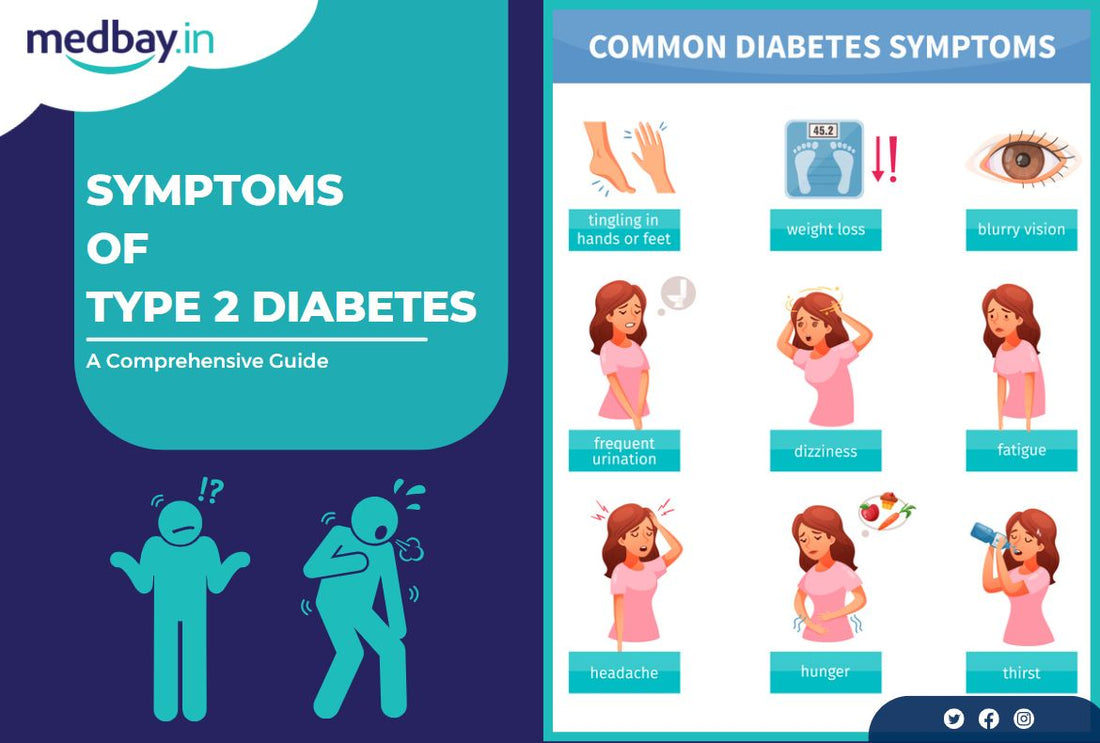Type 2 Diabetes in Women
Diabetes is a generally chronic state of health that gives rise to high blood glucose (sugar) level. The hormone generated by the pancreas, insulin, is in charge of managing blood glucose levels. When the pancreas either doesn't make enough insulin or the body's cells don't react to the insulin that is produced, type 2 diabetes can develop.
Although diabetes can affect anybody, regardless of lifestyle, age, ethnicity, or sex, it can manifest differently in women. Increased thirst, frequent urge to urinate, hunger, exhaustion, and unclear vision are some of the symptoms of type 2 diabetes in women; at times, there may be none.
Diabetes symptoms arise because glucose doesn't get utilised as an energy source and remains in the blood due to a lack of insulin of the body. A person’s body makes effort to reduce blood sugar levels by excreting extra glucose in urine.
Common Symptoms of Diabetes
Listed below are few of the common symptoms of type 2 diabetes in women:
- Extreme thirst
- Frequent urge of urination (especially at night)
- Extreme fatigue
- Weight loss
- Muscle mass loss
- Dizziness
- Cuts or ulcers that take a long time to heal
- Persistent vaginal or penile thrush
- Sight blurring
Impact on Women’s Health
When Trusted Medical Sources examined the link between diabetes and unfavorable health outcomes, researchers discovered that, on average, women with diabetes experienced the following:
- Women have a four times higher chance of developing heart disease than males do.
- 13% higher chance of dying from all causes
- 30% higher chance of cardiovascular disease-related death
- An increased possibility of coronary heart disease death of 58%
- An increase in renal disease prevalence
- Susceptibility to depression
- Weight rise
- Menopause
- Infections of urinary tract
Complication Associated
Chronic diabetes has significant long-term health consequences. Hence, it is best to recognize it early with the aid of the symptoms of type 2 diabetes in women. The most typical reason for blindness and visual loss in adults of working group is type 2 diabetes. Therefore, every yearly diabetic retinopathy eye screenings should be made available to everyone with diabetes age 12 or older.
Early Detection and Management
A higher standard of life may result from recognizing and treating the specific symptoms of type 2 diabetes in women. Women are frequently more probable than men to undergo more serious symptoms from the disease.
The glycated hemoglobin (A1C) test is in general used to identify type 2 diabetes. This blood test measures the average blood sugar level over the course of the previous two to three months.
- Results less than 5.7% are anticipated.
- An estimated 5.7% to 6.4% of people have prediabetes.
- Diabetes is determined when two tests show a 6.5% or higher level.
You might avail for the following tests if the A1C test is unavailable or not feasible due to specific medical circumstances.
- Arbitrary blood sugar test: Blood sugar levels are typically measured in millimoles of sugar per liter (mmol/L) or milligrams of sugar per deciliter (mg/dL) of blood. Irrespective of your last meal, a level of 200 mg/dL (11.1 mmol/L) or above indicates diabetes, particularly if you also exhibit signs of diabetes like severe thirst and frequent urination.
- Blood sugar test after fasting: The blood sample is taken after fasting for the previous night. A healthy level is less than 100 mg/dL (5.6 mmol/L). Prediabetes is defined as a blood sugar level of 100 to 125 mg/dL (5.6 to 6.9 mmol/L). Diabetes is identified when two different tests show 126 mg/dL (7 mmol/L) or above.
- Oral glucose tolerance test: The oral glucose tolerance test does not apply to pregnant women but is utilized more frequently than the others except them. After waiting a certain period of time without eating, the patient should consume something sweet in the doctor's office. After then, blood sugar levels are checked every two hours. Over the span of 2 hours, a level of less than 140 mg/dL (7.8 mmol/L) is regarded as healthy. Prediabetes is defined as blood sugar levels between 140 and 199 mg/dL (7.8 and 11.0 mmol/L). After two hours, a 200 mg/dL (11.1 mmol/L) or greater level indicated diabetes.
- Screening: People under 35 who are obese or overweight and have one or more diabetes risk factors should undergo routine screening with diagnostic tests for type 2 diabetes. pregnant women with gestational diabetes, individuals with prediabetes who have received a diagnosis, children who are overweight or obese, have a family history of type 2 diabetes, or who otherwise face a risk.
Type 1 and type 2 diabetes frequently need different treatments, so if you have diabetes, your healthcare practitioner will need to perform additional tests to differentiate between the two. A1C levels will be checked by your doctor at least twice annually and if your treatment plan changes.
Target A1C targets change with age and other considerations. The American Diabetes Association advises an A1C level under 7% for the majority of persons. Additionally, you get examinations to check for diabetic complications and other illnesses.
Therefore, if you notice any of the symptoms of type 2 diabetes in women listed above, you may detect it early and treat it well. Even when you feel well, take your medications for diabetes and any other health issues together with regular exercise, weight loss, and blood sugar monitoring.
Every day, check your feet for swelling, redness, welts, wounds and blisters (diabetes makes your feet more sensitive). To maintain the health of your mouth, teeth, and gums, brush your teeth and floss every day. To put your life on track, monitor your blood sugar levels.

